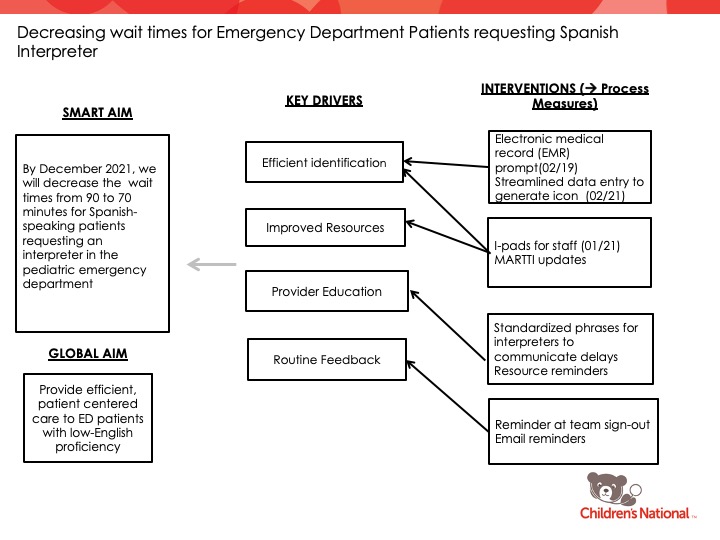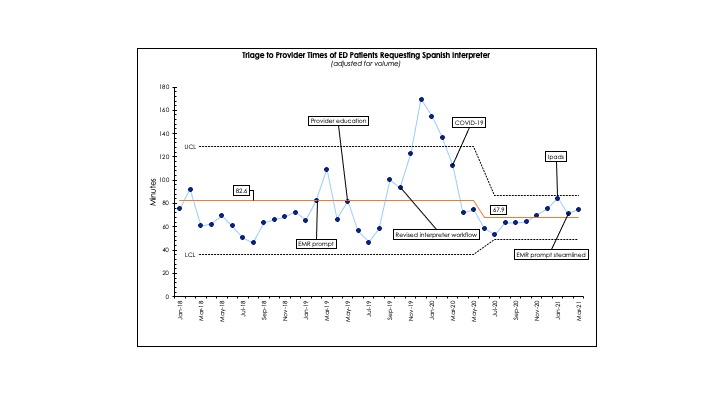Emergency Medicine: All Areas
Category: Abstract Submission
Emergency Medicine XIV
46 - Decreasing wait times for low-acuity emergency department patients requesting a Spanish interpreter
Monday, April 25, 2022
3:30 PM - 6:00 PM US MT
Poster Number: 46
Publication Number: 46.407
Publication Number: 46.407
Gisella Valderrama, Cincinnati Children's Hospital Medical Center, cincinnati, OH, United States; Deena Berkowitz, Children's National Health System, Silver Spring, MD, United States; Gia M. Badolato, Children's National Health System, Washington, DC, United States

Gisella Valderrama, MD
PEM fellow
Cincinnati Children's Hospital Medical Center
cincinnati, Ohio, United States
Presenting Author(s)
Background: Patient-provider communication is critical to safe and effective care delivery. Language barriers affect quality of care in the emergency department (ED). Patients with language barriers experience prolonged wait times, decreased satisfaction, and increased unplanned return visits.
Objective: Our primary aim was to decrease the wait times from 90 to 70 minutes for Spanish speaking patients requesting an interpreter in the ED, between January 2019 and December 2020
Design/Methods: The study was performed in tertiary level pediatric ED with 100,000 annual visits. The target population was Spanish-speaking patients presenting to the ED between January 1st, 2019 and December 31st, 2020 with arrivals between 11 am and 11 pm that was triaged as Emergency Services Index (ESI) levels 4 or 5. Patients were identified if there was a request for interpreter services documented on the nursing assessment. Process mapping identified barriers and solutions. Key interventions included the creation of a new protocol, nursing and provider education, a revised interpreter workflow, electronic medical record prompts, and ongoing staff feedback. Interventions were tested using plan do study act cycles. The primary measure was patient length of stay. The secondary measure was time from triage to provider. The balancing measures were unintended return visits within 72 hours and LWOT rates. We used statistical process control methodology to measure the effects of our interventions over time. We performed a secondary analysis to measure the response of wait times to daily volume comparing pre-intervention to post-intervention.
Results: 7413 patients requested a Spanish interpreter during the 24-month intervention period. Triage to provider times decreased from a mean of 82.6 minutes to 67.9 minutes, a 14.7-minute (17.7 %) decrease. Length of stay decreased from a mean of 180 to 147 minutes, a 33-minute (18%) decrease.
The 72 hr return rate was 2.8% which is not a significant change from our baseline.Conclusion(s): A targeted intervention was associated with a 14-minute (18%) decrease in time to provider for low-acuity Spanish-speaking patients requesting an interpreter. Overall, the ED length of stay decreased by 33 minutes (18%). Return visits within 72 hours were not adversely affected.
Key Driver Diagram
Triage to Provider Times of ED Patients Requesting Spanish Interpreter
Objective: Our primary aim was to decrease the wait times from 90 to 70 minutes for Spanish speaking patients requesting an interpreter in the ED, between January 2019 and December 2020
Design/Methods: The study was performed in tertiary level pediatric ED with 100,000 annual visits. The target population was Spanish-speaking patients presenting to the ED between January 1st, 2019 and December 31st, 2020 with arrivals between 11 am and 11 pm that was triaged as Emergency Services Index (ESI) levels 4 or 5. Patients were identified if there was a request for interpreter services documented on the nursing assessment. Process mapping identified barriers and solutions. Key interventions included the creation of a new protocol, nursing and provider education, a revised interpreter workflow, electronic medical record prompts, and ongoing staff feedback. Interventions were tested using plan do study act cycles. The primary measure was patient length of stay. The secondary measure was time from triage to provider. The balancing measures were unintended return visits within 72 hours and LWOT rates. We used statistical process control methodology to measure the effects of our interventions over time. We performed a secondary analysis to measure the response of wait times to daily volume comparing pre-intervention to post-intervention.
Results: 7413 patients requested a Spanish interpreter during the 24-month intervention period. Triage to provider times decreased from a mean of 82.6 minutes to 67.9 minutes, a 14.7-minute (17.7 %) decrease. Length of stay decreased from a mean of 180 to 147 minutes, a 33-minute (18%) decrease.
The 72 hr return rate was 2.8% which is not a significant change from our baseline.Conclusion(s): A targeted intervention was associated with a 14-minute (18%) decrease in time to provider for low-acuity Spanish-speaking patients requesting an interpreter. Overall, the ED length of stay decreased by 33 minutes (18%). Return visits within 72 hours were not adversely affected.
Key Driver Diagram

Triage to Provider Times of ED Patients Requesting Spanish Interpreter

